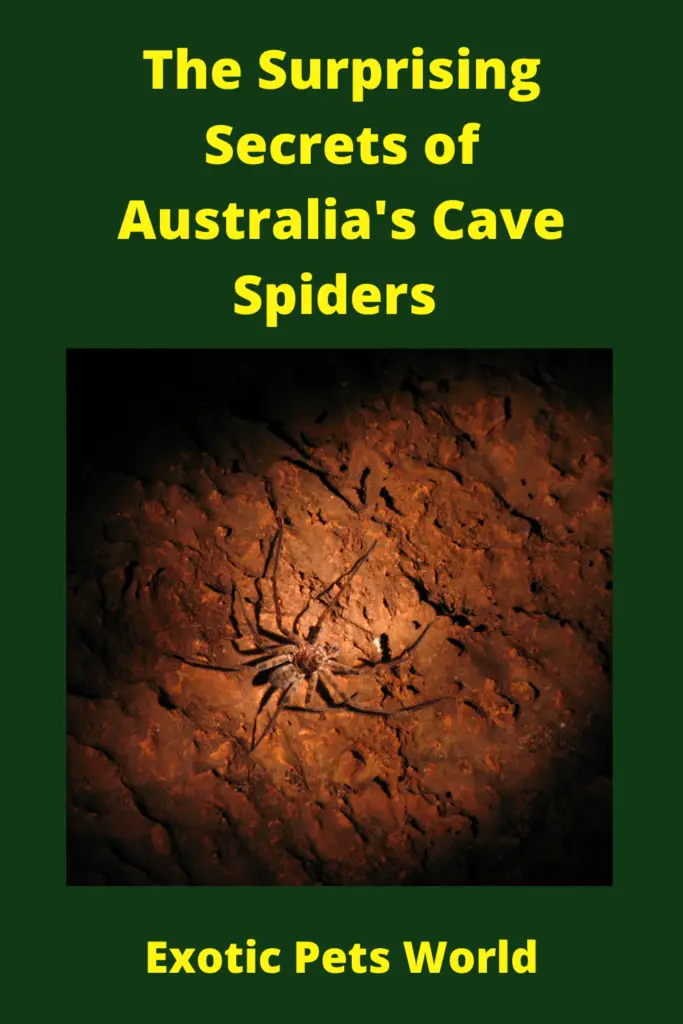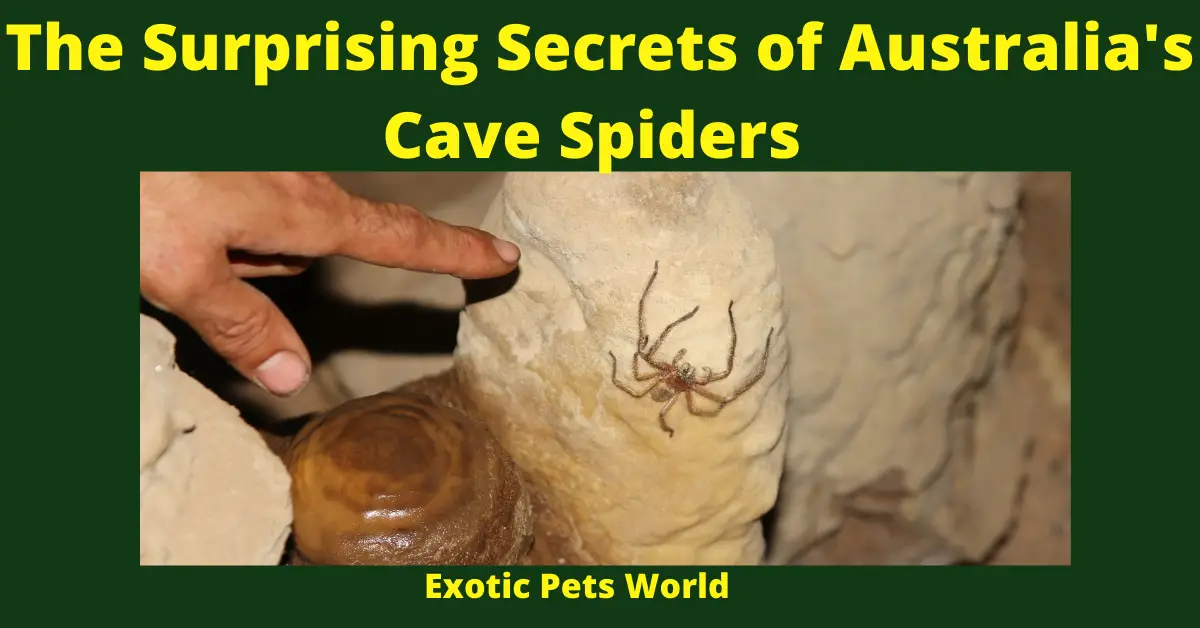Facts about Australia’s Cave Spiders
Australia is known for its unique wildlife. Australian cave spiders are a perfect example. Australian cave spiders are not poisonous but aggressive and territorial, making them less appealing as pets. Australian cave spider populations can grow as large as 10,000 individuals per acre of land! This incredible density has led some scientists to study Australian cave spiders to better understand how humans might live on other planets with extreme climates such as Mars or the moon.
- The Australian Cave Spider is an arachnid that lives in caves
- They are most commonly found in the Northern Territory of Australia
- These spiders have an extensive range, with colonies spanning from Western Australia to Queensland
- One of their most attractive qualities is being able to live without oxygen for up to three weeks at a time by living off their fat reserves
- Their diet consists primarily of insects and other small invertebrates they find on cave ceilings
- They are also preyed upon by bats, birds, and lizards

Description of Cave Dwelling Spiders
The species has been identified as the Cave Dweller spider, an arachnid that typically lives in moist underground passages. It’s believed that recent construction works near these tunnels have disturbed both the spiders and their habitats, which has forced them to move into homes in search of food and water.
How Giant is a Tasmanian cave spider?
The question of just how big the Tasmanian cave spider is has been the subject of some controversy. Some say it’s as big as your hand, while others say it’s only the size of a nickel. If you believe everything you read on the internet, you might think this spider is more significant than your face.
There are several different troglobitic spiders in Tasmania, but their size varies depending on whether they live in the north or south of the island and how deep into the ground they are found. The Tasmanian cave spider that lives the furthest south is found up to 100m below the surface, while those in the north of Tasmania are located only about 25m underground.
People who claim to have seen these spiders say they can be anywhere from 10cm long up to 30cm. The Tasmanian Parks and Wildlife Service says that individual spiders might get bigger than this, but “spiderlings” (immature spiders) are much smaller. A newly hatched spiderling might only be 0.5mm across – 1000 of these would fit on a penny.
The size of a Tasmanian cave spider is debatable, but it’s tiny and harmless to humans. If you see one, admire it from a distance and don’t touch it or try to catch it.
Do Cave Spiders make Spider Webs?
While cave spiders are not a common species of spider, they do exist. Spiders first began to make webs as a way of trapping insects for food. There is some debate as to whether or not cave spiders eat the insects that end up in their webs
There are several non-cave species of most spiders that make webs to catch prey. Cave spiders are an interesting species because they live in dark places and can be very small or large. It is thought that cave spiders use their webs to catch food. However, there is a lack of evidence that proves this theory.
There are different kinds of cave spider webs observed, but the tiny cave spider isn’t known for making web-like structures because it lives in dusty areas and does not produce silk. Some of the most famous cave spiders include Meta menardi and Meta bourneti, although there is some debate over whether or not they make webs or if their diets consist mainly of cannibalism.
What is the Lifespan of a Cave Spider?
Cave spiders are an endangered species which is why it is essential to learn about their lifespan. The average cave spider’s lifespan lasts anywhere between three weeks and one month. One reason for their short life cycle could be the poor food quality available in caves, making it difficult to survive. Cave spiders are commonly found in damp, dark places and underground worlds like cave entrances and railway tunnels. They primarily eat beetles and other small insects that live in caves.
Are Tasmanian cave Spiders Poisonous?
The Tasmanian Cave Spider is a Tasmanian spider that belongs to the group of mygalomorphs. It lives in the temperate rainforest regions of Tasmania, Australia, and New Zealand. The Tasmanian Cave Spiders are also known as horrors from down under or trapdoor spiders. These spiders catch their prey, usually insects and other small animals, with the help of a glue-like substance emitted from their mouth to make them stick to it. The Tasmanian Cave Spider can be found in dark crevices or caves.
Tasmanian cave spiders are dangerous to humans and can bite if threatened. Tasmanian cave spiders are all venomous creatures, but one type of toxin, Tasmanian Spider Venom, is nontoxic for humans. Tasmanian Spider Venom Tasmanian Cave spiders are fascinating in their venom, and Tasmanian cave spider venom is produced in two different glands. The two types of Tasmanian spider venom are toxic only to insects and a more potent toxin, paralyzing small creatures such as mice. It has been found that Tasmanian Cave Spiders can hunt more effectively when they combine their poison with their glue-like secretion. Tasmanian Spider Venom Tasmanian cave spiders usually do not attack humans but try to escape or play dead.

Are Cave Spiders Dangerous?
Depending on their age, they are around ( 3″ – 4″ ) 8-10cm long and range from reddish-brown to black. It is said that cave spiders have venom so potent, they can dissolve anything – including skin, bone, and cave goblin armor.
Some of the Giant Huntsmans spiders can get up to 10″ in size
Cave spiders are usually found in small groups, but more enormous cave spider nests have been discovered with over 100 cave spiders – which is extremely dangerous for experienced adventurers.
. However, cave spiders are dangerous because they are so small and hard to see in their natural environment – which is dark cave systems. This means that cave spiders often attack people when they least expect it!
Most cases have been reported to have involved cave spiders biting someone’s leg, with the poison working its way up into the heart.
These cave spiders are dangerous because of their aggressive behavior combined with their venomous abilities. It is advised to take caution if you enter cave systems, incredibly dark cave systems.
Are African Cave-dwelling Spiders Poisonous?
The African cave-dwelling spiders are venomous, and the African tarantulas even more so. African cave-dwelling spider bites can produce quite a bit of pain; however, they are not deadly to humans, though it may be slightly dangerous to get bitten by one of them. One of the most common African cave-dwelling spiders is called African unident.
They are not the only African cave-dwelling spiders, though some of the most well-known African tarantulas. These are often found in dark niches and hollows within buildings or other structures and inside logs. They like to make their homes in crevices or voids of African caves, where they get their name. African cave-dwelling spiders do not spin webs in African cave dwellings, so they are sometimes mistaken for African house spiders.
Diet – What do Cave Spiders Eat?
Cave spiders are found in numerous locations and habitats. They love to build their homes underneath rocks and stone-like objects, allowing them to blend into the surroundings while they wait for prey. Some cave spider species even use vibrations to communicate or hunt their prey.
Cave spiders eat insects such as crickets, roaches, and other bugs that fall into their caves. Some cave spiders also eat other species. The diet of a cave spider depends on the location and habitat where it lives.

Do Cave Spiders Make Good Pets?
Well, the simple answer to that question is yes. Cave spiders are very gentle and easy to handle; they don’t tend to bite their owners, even when provoked. Although taking a cave spider can be a little nerve-wracking at first, it becomes effortless with time.
Cave spiders are not challenging to look after. The only main requirement is that they need to be fed regularly or go into a state of Starvation, which will eventually kill them if left untreated. Providing your cave spider should be fed every day or two, and any food they don’t eat should be removed after a certain period to avoid fungus and mold problems in your arachnid’s tank. Fungus and molds will eventually spread over the surface in which it is in and can cause health problems for your spider and damage or destroy its silk-making net, causing severe stress.
Final Thoughts
Meet Australia’s cave spiders. They are smaller than your fingernail but mind-blowing in their biology and behavior. Cave Spiders are unique to mainland Australia and build funnel webs to catch insects, lizards, and bats!
A species of Australian spider has the world’s most robust biological material, according to research published in the latest issue of PNAS. The tough silk, spun by tiny spiders found in limestone caves in southeast Australia, is stronger than Kevlar.
